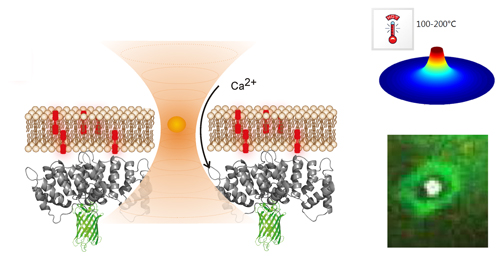Physics knowledge about the cell’s puncture kit can be used in cancer treatment
Poul Martin Bendix, researcher in biocomplexity at the Niels Bohr Institute, University of Copenhagen, has received 15 million DKK to research the cell’s surface repair in collaboration with the Danish Cancer Society and University of Southern Denmark. The self-healing ability of cells is very different when comparing normal cells to cancer cells, and this project utilizes techniques from physics in order to understand how cells reseal holes in their membranes. The other participants in the collaboration are Jesper Nylandsted from the Danish Cancer Society, and Adam Cohen Simonsen and Himanshu Khandelia from University of Southern Denmark

The figure in the upper right corner shows the temperature distribution from the particle: The top corresponds to the position of the particle and the temperature drops, when the distance to the surface of the particle increases.
In the lower right corner a gold particle (white) has ruptured the cell membrane. Circling the particle is a ring of annexins (the green colour). The hole is viewed from above
Cancer cells have a puncture kit that works all too well
Cancer cells are very good at repairing the ruptures that emerge when moving around in the body. They are flexible and can squeeze in everywhere. Still, they get stuck from time to time, and ruptures in their membranes emerge. But they command a tuned up genetic mechanism and produce more of the proteins that repair the holes. Part of the aim of this project is so understand this mechanism better. Only when understood can we manipulate it.
Gold, laser beams and artificial cell membranes
The biophysicists at the Niels Bohr Institute have techniques to shoot tiny holes in cell membranes. Subsequently they observe what happens in the cell – which proteins or annexins, as they are rightly called, gather at the puncture to repair it and how do they work? The researchers place a tiny ball of gold on the surface of the cell and shoot it with a laser beam. The ball heats up momentarily to two hundred degrees and punctures the cell membrane. The cell itself isn’t damaged, as only a nanoscopic area of the membrane is affected, and then it is possible to observe the healing process.
But that’s not all. The researchers produce artificial membranes themselves and fill them with pure annexins. In other words, only one type of annexin can bind to the membrane, so it is possible to observe the behavior of the annexins one at a time, when the membrane is punctured. This refines our understanding of which annexins are important to boost or reduce – if we want to regulate the auto-repair ability of the cells. If we can destroy the enhanced ability of cancer cells to repair, by manipulating their content of different types of annexin, it could be an important tool in cancer treatment.
Physics is combined with techniques from biology
Jesper Nylandsted, molecular biologist from the Danish Cancer Society, has another technique, CRISPR, with which he can edit the genetic code of the cells. This way the production of certain types of annexins can be put on hold, and the consequences for the cell’s auto-repair ability, when e.g. “annexin 4” is no longer available, can be observed. Obviously, it is crucial to find out which proteins are important for invasive cancer cell’s enhanced self repair ability. If we can “turn them off”, another tool in the treatment of the disease is available. This is how the combination of several fields of research gives us a better hand to play, so to speak.
Collaboration between different scientific approaches yields results
“Perhaps one can say that the physics approach is to research and gain an overview of the entire foundation for how the biophysics of the cell works. The Danish Cancer Society is more into the therapeutic aspect – they need to find treatments. And they can benefit from the techniques and realizations that physics has to offer”, says Poul Martin Bendix. “We’ve already shown that our synergy works well and the project benefits from our different methods. Himanshu Khandelia from University of Southern Denmark provides the theoretical backup modelling the interaction between the proteins and the membrane. Adam Cohen Simonsen, also from SDU, measures the ultra-sensitive interactions between proteins and the cell membrane, using atomic force microscopy. It provides us with an image of the role of the single protein when repairing the cell membrane, which again leads to a deeper mechanistic insight into the repair process. Overall, we expect to gain a much more coherent picture of how the membrane repair system of the cell works – potentially with cancer treatment on the horizon”, Poul Martin Bendix continues.
Basic research in biophysics is key – and has many potentials
Cancer treatment is not the only perspective. New knowledge on the puncture kit of the cells is most likely useful in other fields of research. “Amyloids are formed in Alzheimer’s and Parkinson’s disease, and they tend to rupture the cells, e.g. the nerve cells. This poses a threat to the cells, because a ruptured cell will absorb excessive amounts of calcium, which causes it to die. The techniques we are developing could be useful in improving the auto repair system of the cells. Plainly put, it is important to find out how these mechanisms really work on a very fundamental level”, Poul Martin Bendix explains.
Topics
See also:
Contact
Pól Martin Bendix, Associate Professor at Biocomplexity, Niels Bohr Institute, University of Copenhagen
Email: bendix@nbi.ku.dk, Phone: +45 35 32 52 51 Mobile: +45 61 60 24 54
